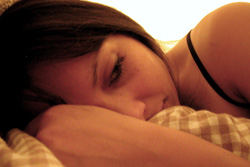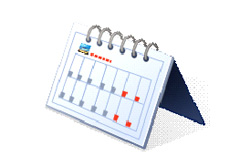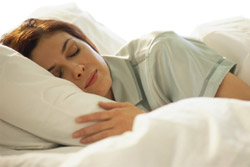- What is primary insomnia (idiopathic insomnia)?
- Statistics on primary insomnia
- Risk factors for primary insomnia
- Progression of primary insomnia
- Symptoms of primary insomnia
- Clinical examination of primary insomnia
- How is primary insomnia diagnosed?
- Prognosis of primary insomnia
- Treatment of primary insomnia
- Primary insomnia prevention
- References
What is primary insomnia (idiopathic insomnia)?

Insomnia often occurs secondary to psychological disturbances and depression, known as secondary insomnia (or comorbid insomnia).
Insomnia can also occur in the absence of any other underlying medical conditions, known as primary insomnia (or idiopathic insomnia). The main complaint with primary insomnia is difficulty getting to sleep or maintaining sleep. Insomnia can have a major effect on quality of life, productivity and mental health.
 |
This page focuses on primary insomnia. For more information on insomnia in general, see Insomnia. |
Patterns of insomnia
There are three different patterns of insomnia:
- Onset insomnia;
- Middle insomnia; and
- Terminal insomnia.
Onset insomnia
Onset insomnia involves difficulty falling asleep. This type of insomnia is often associated with elevated levels of arousal and can be associated with anxiety disorders. Onset insomnia is defined as taking more than 30 minutes to fall asleep.
Middle insomnia
Middle insomnia refers to waking in the middle of the night and difficulty sleeping for long periods. This type of insomnia can often be the result of pain or other illness.
Terminal insomnia
Terminal insomnia occurs in individuals who wake up too early in the morning. Terminal insomnia is common in the elderly, in individuals experiencing depression, and in women going through menopause.
Insomnia as classified over time

- Transient insomnia;
- Cyclical insomnia; and
- Chronic insomnia.
Transient insomnia
The diagnosis of transient insomnia is often made once it has been relieved. It is usually defined as insomnia that lasts for less than 3 weeks. Often transient insomnia is linked to an event that has been particularly traumatic. It is as common in men as in women, and is more likely if there is a previous history of a sleep disorder or if the individual can become very emotional.
Transient insomnia can be triggered by a number of factors, including:
- Changes to the sleep environment: Physical stimuli (noise, light, movements), an unfamiliar environment;
- A high state of arousal: Due to emotional events (grieving, excitement, worry, anxiety, pain, illness);
- Poor sleep hygiene: Irregular sleeping patterns, excessive consumption of substances that delay sleep; and
- Short-term disruption of the “body clock“: Induced by rotating shift work or jet lag.
Cyclical insomnia
Cyclical insomnia is less common than transient insomnia. It involves a lack of balance between sleep and wake cycles. Cyclical insomnia may occur briefly or may be an issue throughout the life of a particular individual. The insomnia may recur at the same time as changes within the body, as in disorders of the body clock or premenstrual insomnia.
Chronic insomnia
Primary chronic insomnia is thought to occur in individuals who are in a state of hyperarousal. Chronic insomnia is associated with muscle fatigue, hallucinations and mental fatigue. Individuals also report double vision and a feeling of being in slow motion.
Statistics on primary insomnia

One third of adults experience some degree of insomnia in any given year, and 2–6% use medications to aid sleep.
Insomnia is particularly common in individuals with disrupted circadian rhythms, such as shift workers and individuals experiencing jet lag. Acute insomnia may also occur in individuals experiencing trauma such as the loss of a loved one. While insomnia following a tragedy often only occurs for the days or weeks following the event, if an individual does not receive appropriate counselling and grief management, the insomnia can become chronic.
Risk factors for primary insomnia
There are no risk factors that put a person at greater risk of having primary insomnia. By definition, the primary complaint is the insomnia itself.
Symptoms of primary insomnia

- Excessive daytime tiredness;
- Physical weariness;
- Fatigue;
- Muscle aches: These are common and are often more severe in the limbs. Muscle aches can also precipitate neck and head aches. The aches are likely a result of the increased muscle tension, since the muscles miss out on the normal inhibition of motor activity that occurs during sleep;
- Increased risk of falls (particularly in the elderly);
- Hypertension (high blood pressure);
- Poor immune system function;
- Susceptibility to obesity;
- Increased risk of cardiovascular disease; and/or
- Increased risk of diabetes.
The psychological symptoms of insomnia include:
- Loss of concentration;
- Deterioration of memory;
- Irritability and mood disturbances;
- Anxiety and depression;
- Loss of motivation;
- Fear regarding long-term effects of insomnia; and/or
- Over-thinking at bedtime: These thoughts often centre around a fear of not sleeping or frustration and anxiety regarding the insomnia.
Effects of insomnia
Measurements of brain waves recorded by an electroencephalograph (EEG) show less deep sleep activity during sleep in individuals with primary insomnia than in people without primary insomnia. Alpha brain waves are also more common, indicating that an individual with primary insomnia is more easily woken by stimuli (e.g. noise and light). It is associated with an increased awareness of thinking during sleep and with feeling un-refreshed in the morning.
In individuals with primary insomnia, less melatonin is released, and greater brain blood flow has been recorded during sleep. Oxygen uptake during stage 3 and 4 non-REM sleep is increased in people with primary insomnia compared to normal subjects. People with primary insomnia have a higher heart rate during sleep than normal people. All these findings suggest that a state of hyperarousal causes primary insomnia.
Clinical examination of primary insomnia

The physician will take a detailed clinical history from the individual, including:
- Presence of chronic medical conditions (including arthritis, allergies, congestive heart failure, and benign prostatic hypertrophy);
- Medication use (including decongestants, beta agonists, corticosteroids, beta blockers, diuretics, antidepressants and H2 blockers);
- Family history of sleep disorders; and
- Presence of psychiatric illnesses (such as anxiety, depression and panic disorders).
The physician may interview relatives or caregivers to get a better understanding of the individual’s:
-
Sleep habits:
-
Hours of sleeping;
- Sleep position;
-
Snoring;
-
Sleep and awakening times.
-
-
Type of bed, pillows, etc;
-
Daytime functioning;
-
Eating habits in the evening;
-
Alcohol intake; and
-
Substance use.
This information may help the physician understand the nature of the insomnia and help to tailor various interventions to try to reduce the insomnia.
The physician or specialist may ask the individual to keep a detailed sleep diary. This will involve writing down substance use, the times of going to bed, nighttime awakenings, nightmares, total amount of time spent sleeping and how the individual feels upon waking in the morning.
A diagnosis of chronic insomnia is made if an individual experiences problems failing asleep, poor sleep quality or too little sleep, at least 3 times a week for at least 1 month. This lack of sleep must be associated with some reduced performance in the daytime.
Other more specialised tests can be conducted if the individual does not respond well to drugs and/or behavioural adjustments.
A polysomnograph is a test that measures the time taken to fall asleep. It can measure this time multiple times if an individual wakes frequently. This test is particularly useful in individuals who are suspected to have sleep apnoea and periodic limb movement disorder. A polysomnograph may also be used for individuals with signs of daytime sleepiness, excessive snoring, and a body mass index (BMI) greater than 35.
An activity monitor that records movement can also be worn on the wrist. The absence of movement over an extended period indicates that the individual is asleep.
In a small percentage of cases where structural changes in the brain are suspected, neuroimaging such as a MRI or CT can be performed.
How is primary insomnia diagnosed?
The diagnosis of primary insomnia is made after the physician has taken a detailed clinical history and examined the individual’s sleep diary to ascertain whether the individual is not obtaining enough sleep or good quality of sleep, resulting in excessive daytime tiredness. Many sleep tests and psychological assessments may need to be carried out to rule out various medical and/or psychological causes of insomnia before a diagnosis of primary insomnia is made (i.e. the diagnosis of primary insomnia is often made after excluding all known conditions that can cause insomnia.)
Prognosis of primary insomnia

Cyclical insomnia may occur for a brief period, or may be an issue throughout the life of an individual.
Transient insomnia usually lasts for less than 3 weeks. However, while insomnia following a traumatic event often only occurs in the days or weeks following the event, it can become chronic if an individual does not receive appropriate counselling and grief management.
Cognitive behavioural therapy and improved sleep hygiene are very effective as primary interventions for alleviating insomnia. If these treatment options are not effective, then pharmacological agents may be considered. In general, insomnia can be treated well in the majority of people.
Treatment of primary insomnia

Treatment options for chronic insomnia are divided into pharmacological and non-pharmacological interventions.
Non-pharmacological interventions
Cognitive behavioural therapy
Cognitive behavioural therapy addresses an individual’s incorrect beliefs and attitudes towards sleep (e.g. unrealistic expectations, misconceptions). Techniques include reattribution training (e.g. goal setting and planning appropriate coping responses), decatastrophising, and attention shifting.
Cognitive behavioural therapy and other behavioural therapies, including relaxation therapy and sleep restriction, have been shown to produce reliable and long-lasting improvements in individuals suffering with chronic insomnia.
Relaxation therapy
Relaxation therapy involves tensing and relaxing different muscle groups, meditation and hypnosis.
Sleep restriction
Sleep restriction is an approach in which an individual spends less time in bed. The aim is that the individual then associates time spent in bed with time spent sleeping. Bedtimes are then increased or decreased, depending on sleep quality and duration. This state of minimal sleep deprivation can eventually lead to improved quality of sleep
Exercise
Moderate-intensity level exercise can be useful, but should not be undertaken just before bedtime. Exercise has been shown in some studies to be as effective at improving sleep as benzodiazepines.
Avoiding stimuli
Avoiding stimuli before bedtime can promote more efficient sleep and decrease the amount of time taken to fall asleep. Stimuli to avoid at night include:
Restricting use of the bedroom
Restricting the use of the bedroom to sleep and intimacy, and leaving the bedroom if unable to fall asleep within 20 minutes can, over time, help an individual to associate the bedroom with sleeping, and increase sleep efficiency.
 |
For more information, see Sleep Hygiene. |
Pharmacological interventions

Prolonged-release melatonin
Melatonin is a key regulator of the sleep-wake cycle. It is the intrinsic signal of darkness in the body, and resets the body clock and physiologically promotes and regulates sleep.
Prolonged-release melatonin (Circadin) is a slow release form of melatonin that mimics the release of naturally occurring melatonin in the body. Prolonged release melatonin is used to improve sleep quality and morning alertness, particularly in the elderly. In clinical trials there is no evidence of dependency or withdrawal symptoms; and no rebound insomnia after the medication is stopped (i.e. the severity of insomnia after stopping the medication is no worse than the insomnia before treatment started).
Benzodiazepine hypnotics
Benzodiazepines increase sleep time and improve sleep duration. Drugs with shorter half-lives are preferred to minimise drowsiness in the morning.
While inducing unconsciousness, benzodiazepines actually worsen sleep quality as they promote light sleep and decrease time spent in deep REM sleep. Tolerance and dependence can also occur with prolonged use; thus, benzodiazepines are most useful for alleviating insomnia in the short term.
Withdrawal can be associated with anxiety, depression, nausea, rebound insomnia, nightmares and impaired memory. Gradual drawing back of the dose alone is ineffective in achieving long-term cessation of benzodiazepine use. However, in 70% of cases, successful discontinuation can be achieved by combining tapering of the dose and cognitive behavioural therapy.
Nonbenzodiazepine hypnotics
This is a newer class of drugs. Unlike benzodiazepines, nonbenzodiazepines have minimal impact on sleep stages and no REM sleep rebound. Nonbenzodiazepines are cleared by the liver; doses should be reduced in the elderly with impaired liver function.
Zopiclone (e.g. Imovane, Imrest) has a bitter taste, which is its most common adverse effect. Zolpidem (e.g. Dormizol, Somidem, Stildem, Stilnox, Zolpibell) can cause hallucinations in a small percentage of people. Your doctor will stop treatment should these occur. Zaleplon has a short half-life, making it useful for sleep-onset insomnia. It may also be used during the night if an individual cannot fall asleep, as it has less risk of causing drowsiness the following morning.
Barbiturates
Barbiturates function to decrease time to sleep onset and reduce REM sleep. They may be useful in the short term (< 2 weeks) but loose their ability to induce and maintain sleep with longer use. Extended use is associated with tolerance and psychological and physical dependence. Barbiturates are not recommended as sleep aids.
Antihistamines
Nearly 25% of individuals who experience insomnia use over-the-counter medication to aid sleep. Use of antihistamines should be discouraged since they are minimally effective at inducing sleep, reduce sleep quality and cause drowsiness.
Herbal and dietary supplements
There are many herbal and dietary supplements that have been advocated as sleep aids. These include valerian root, lavender, passionflower, St John’s wort, glutamine, niacin and tryptophan. There is some evidence of benefit for all of these, except valerian root.
More Information
 |
For more information about sleep, including how much is good for you, tips for getting more sleep, and sleep disorders, as well as some useful videos, see Sleep. |
Primary insomnia prevention
Insomnia can be prevented in some cases through good sleep hygiene, including simple but effective lifestyle and dietary modifications.
 |
For more information, see Sleep Hygiene.
References
- Sleep Health Australia. Wake up Australia: The value of healthy sleep [online]. Barton, ACT: Access Economics; October 2004 [cited 15 June 2010]. Available from: URL link
- Wilson C, Lack L. Sleeping habits of people living in the Adelaide metropolitan area: A telephone survey. Aust Psychologist. 1983;18(3):369-76. [Abstract]
- Grunstein R. Insomnia diagnosis and management. Aust Fam Physician. 2002;31(11):995-1000. [Abstract | Full text]
- Shneerson JM. Sleep Medicine: A guide to sleep and its disorders (2nd edition). Oxford: Blackwell Publishing; 2005. [Book]
- Ohayon MM. Epidemiology of insomnia: What we know and what we still need to learn. Sleep Med Rev. 2002;6(2):97-111. [Abstract]
- International Classification of Sleep Disorders: Diagnostic and coding manual (2nd edition). Westchester, IL: American Academy of Sleep Medicine; 2005. [Book]
- Ramakrishnan K, Scheid DC. Treatment options for insomnia. Am Fam Physician. 2007;76(4):517-26. [Abstract | Full text]
- Holbrook AM, Crowther R, Lotter A, et al. The diagnosis and management of insomnia in clinical practice: A practical evidence-based approach. CMAJ. 2000;162(2):216-20. [Abstract | Full text]
- Ringdahl EN, Pereira SL, Delzell JE Jr. Treatment of primary insomnia. J Am Board Fam Pract. 2004;17(3):212-9. [Abstract | Full text]
- Edinger JD, Wohlgemuth WK, Radtke RA, et al. Cognitive behavioral therapy for treatment of chronic primary insomnia: A randomized controlled trial. JAMA. 2001;285(14):1856-64. [Abstract | Full text]
- King AC, Oman RF, Brassington GS, et al. Moderate-intensity exercise and self-rated quality of sleep in older adults. A randomized controlled trial. JAMA. 1997;277(1):32-7. [Abstract | Full text]
- Ebben MR, Spielman AJ. Non-pharmacological treatments for insomnia. J Behav Med. 2009;32(3):244-54. [Abstract]
- Montgomery P, Dennis J. Cognitive behavioural interventions for sleep problems in adults aged 60+. Cochrane Database Syst Rev. 2003;(1):CD003161. [Abstract | Full text]
- Kupfer DJ, Reynolds CF 3rd. Management of insomnia. N Engl J Med. 1997;336(5):341-6. [Abstract]
- Tiller JWG. The management of insomnia: An update. Aust Prescr. 2003;26(4):78-81. [Full text]
- Scharf MB, Roth T, Vogel GW, Walsh JK. A multicenter, placebo-controlled study evaluating zolpidem in the treatment of chronic insomnia. J Clin Psychiatry. 1994;55(5):192-9. [Abstract]
-
Lee-Chiong TL. Sleep Medicine: Essentials and review. Oxford: Oxford University Press; 2008. [Book]
- Wade A, Downie S. Prolonged-release melatonin for the treatment of insomnia in patients over 55 years. Expert Opin Investig Drugs. 2008;17(10):1567-72. [Abstract]
-
Lemoine P, Nir T, Laudon M, Zisapel N. Prolonged release melatonin improves sleep quality and morning alertness in insomnia patients aged 55 years and older and has not withdrawal effects. J Sleep Res. 2007;16(4):372-80. [Abstract | Full text]
- Assessment report for Circadin. Procedure No. EMEA/H/C/695. London: European Medicines Agency; 2007. Available from: URL link
- Luthringer R, Muzet M, Zisapel N, Staner L. The effect of prolonged-release melatonin on sleep measures and psychomotor performance in elderly patients with insomnia. Int Clin Psychopharmacol. 2009;24(5):239-49. [Abstract]
All content and media on the HealthEngine Blog is created and published online for informational purposes only. It is not intended to be a substitute for professional medical advice and should not be relied on as health or personal advice. Always seek the guidance of your doctor or other qualified health professional with any questions you may have regarding your health or a medical condition. Never disregard the advice of a medical professional, or delay in seeking it because of something you have read on this Website. If you think you may have a medical emergency, call your doctor, go to the nearest hospital emergency department, or call the emergency services immediately.







